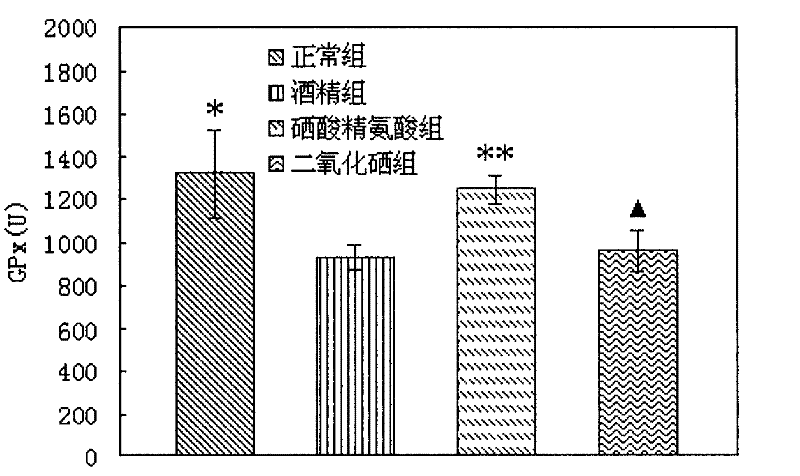A Novel Selenic Acid Biomaterial with the Function of Protecting Alcoholic Liver Injury
A technology of alcoholic liver injury and biomaterials, applied in the field of food science, can solve the problems of narrow safe dosage range of selenium, achieve broad development and utilization prospects, high absorption rate, and reduce the degree of cell inflammation
- Summary
- Abstract
- Description
- Claims
- Application Information
AI Technical Summary
Problems solved by technology
Method used
Image
Examples
Embodiment 1
[0018] Embodiment 1: Grouping and administration of experimental animals
[0019] After one week of normal feeding, the mice were randomly divided into 4 groups, 15 in each group, namely the normal group, the alcohol group, the arginine selenate group and the selenium dioxide group. The daily recommended intake of selenium is 100 μg·d -1 ·60kg -1 10 times of the dose is the mouse dose, and the arginine selenate group and the selenium dioxide group are gavaged with this dose for one week, and the normal group and the alcohol group are gavaged with the same amount of distilled water. One week later, the alcohol group, the arginine selenate group, and the selenium dioxide group were intragastrically administered 12 mL·kg of 56° liquor every day. -1 ·Bw, intragastric administration twice a day, at the same time, the arginine selenate group and the selenium dioxide group continued intragastric administration of the same dose of drugs, and the normal group was intragastric adminis...
Embodiment 2
[0020] Embodiment 2: Grouping and administration of experimental animals
[0021] After one week of normal feeding, the mice were randomly divided into 4 groups, 15 in each group, namely the normal group, the alcohol group, the arginine selenate group and the selenium dioxide group. The daily recommended intake of selenium is 100 μg·d -1 ·60kg -1 30 times of the dose is the dose for mice, the arginine selenate group and the selenium dioxide group are gavaged with this dose for one week, and the normal group and the alcohol group are gavaged with the same amount of distilled water. One week later, the alcohol group, the arginine selenate group, and the selenium dioxide group were intragastrically administered 12 mL·kg of 56° liquor every day. -1 ·Bw, intragastric administration twice a day, at the same time, the arginine selenate group and the selenium dioxide group continued intragastric administration of the same dose of drugs, and the normal group was intragastric administ...
Embodiment 3
[0022] Embodiment 3: Grouping and administration of experimental animals
[0023] After one week of normal feeding, the mice were randomly divided into 4 groups, 15 in each group, namely the normal group, the alcohol group, the arginine selenate group and the selenium dioxide group. The daily recommended intake of selenium is 100 μg·d -1 ·60kg -1 40 times of the dose is the dose for mice, the arginine selenate group and the selenium dioxide group were gavaged with this dose for one week, and the normal group and the alcohol group were gavaged with the same amount of distilled water. One week later, the alcohol group, the arginine selenate group, and the selenium dioxide group were intragastrically administered 12 mL·kg of 56° liquor every day. -1 ·Bw, intragastric administration twice a day, at the same time, the arginine selenate group and the selenium dioxide group continued intragastric administration of the same dose of drugs, and the normal group was intragastric admini...
PUM
 Login to View More
Login to View More Abstract
Description
Claims
Application Information
 Login to View More
Login to View More - R&D
- Intellectual Property
- Life Sciences
- Materials
- Tech Scout
- Unparalleled Data Quality
- Higher Quality Content
- 60% Fewer Hallucinations
Browse by: Latest US Patents, China's latest patents, Technical Efficacy Thesaurus, Application Domain, Technology Topic, Popular Technical Reports.
© 2025 PatSnap. All rights reserved.Legal|Privacy policy|Modern Slavery Act Transparency Statement|Sitemap|About US| Contact US: help@patsnap.com



